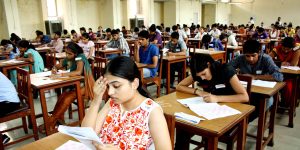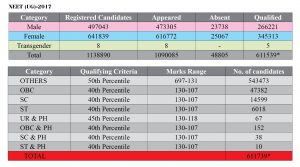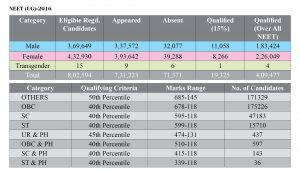Nurturing Excellence in Doctors
National Eligibility–cum-Entrance Test (NEET) is a pathbreaking step to improve the quality of new entrants to medical profession. The efforts of Medical Council of India (MCI), Ministry of Health and Family Welfare (MoHFW) and the Supreme Court are undoubtedly laudable to bring medical aspirants under one ambit. However, the qualifying merit of NEET should not be lowered to fill vacant medical seats….
By Dr (Prof) Raj Bahadur

Quality is a measure of excellence or state of being free from deficiencies and significant variations. It is brought about by strict and consistent commitments to certain standards that achieve uniformity. Medical profession in that matter deserves human resources who do not compromise the quality of healthcare. This all has been enshrined in “Hippocrates Oath” that there should be “non-maleficence “ i.e. “to do no harm”. To ensure it, the society expects that medical professional should be well versed with the latest knowledge and skills.
Although all human beings are vested with sufficient brain power to acquire knowledge and skill, but when it refers to taking care of human life, acquisition of knowledge in medicine should be excellent in quality. In addition, more important is to have inculcated the quality of compassion.
While the principle that education must not be a commodity that can be purchased without merit is a sound one but the stark reality of medical education bazaar in our country has disturbing implications.
National Eligibility-cum-Entrance Test (NEET) has been introduced following extensive churning to improve the quality of medical aspirants. An analysis of the data put together by the CBSE, which conducts the NEET, to underline the issue of quality of medical students reflects the health care delivery of country.
According to this data, 11, 38,890 candidates were registered for NEET-2017. Out of these, 10, 90,085 appeared at the NEET examination. Among these, 6, 11,739 candidates were declared as NEET qualified on the basis of minimum qualifying criteria of NEET – UG 2017 (50/40th percentile). It was further observed that as many as 5, 43,473 candidates had qualifying criteria as 50th percentile with marks range between 697 – 131 out of total 720. While in the cohort of 40th percentile among various categories the marks ranged between 130 and 107 out of 720. (Candidates over 130 marks in case of reserved category were considered against General Category, wherever eligible).
From these figures, it is evident that in the group of 50th percentile, candidates securing as high as 96.8% marks and getting as low as 18.2% marks were eligible for admission to MBBS course. This group had as many as 5, 43,473 candidates. Similarly, in the group of 40th percentile, the maximum marks obtained was 18.05% of total and the low was 14.8%. These included 68,266 candidates.
 NEET (UG)-2017
NEET (UG)-2017
Similarly, in the year 2016, a total of 8, 02,594 were registered candidates of which 7, 31,223 appeared in the NEET examination. Among these, 4, 09,477 candidates were declared as NEET qualified on the basis of minimum qualifying criteria of NEET – UG 2016 (50/40th percentile). It was further observed that as many as 1, 71,329 candidates had qualifying criteria as 50th percentile with marks range between 685 – 145 out of total 720 marks. While in the cohort of 40th percentile among various categories the marks ranged between 678-118 out of total 720. From these figures, it is evident that in the group of 50th percentile, candidates securing as high as 95.1% and as low as 20.1% were eligible for admission to MBBS course. This group had as many as 1, 71,329 candidates. Similarly, in the group of 40th percentile, the maximum marks obtained were 94.1% and lowest were 16.3% marks and these were 2, 38,148 candidates. (Here the candidates were considered in their respective categories as compared to the data reflected in NEET 2017, where the candidates of reserved categories were shown to be considered in general category).
 NEET (UG) – 2016
NEET (UG) – 2016
The above statistics reveals that for the academic year 2017-18 the candidates securing 18.2 percent marks, i.e. 131 out of 720 in the general category and 14.8 percent marks, i.e. 107 out of 720 were eligible for admission. Similarly, in the academic year 2016-17, the candidates securing 20.1 percent marks, i.e. 145 out of 720 in the general category and 16.3 percent marks, i.e. 118 out of 720 were eligible for admission.
NEET which is a competitive eligibility examination has allowed the admissions of candidates who were lower in ranks, which probably would have never ever been admitted in medical colleges from 1947 to 2017. The ones who lose out for admission following NEET, must often be the weakest students in terms of money and influence, whose only asset may be merit, that probably does not count much in our country.
The very purpose of the competitive examination stands defeated, when one has to fill the required number of seats in a medical college with all and sundry, rather than best available candidates under the guise of 50th/40th percentile.
At this juncture, it appears that to ensure that the admissions are of meritorious candidates, only three times the sanctioned intake capacity in MBBS course in the country should be deemed to be eligible irrespective of the percentile secured in the NEET examination.
The Government, to provide sufficient doctors in the healthcare delivery apparently matching the WHO norms, is adopting a two-pronged strategy to increase the number of seats and simultaneously is reducing the eligibility merit in the qualifying examination at both U.G. and P.G. levels.
The feedback taken from the meritorious students, who had given up seats in private institutions despite higher merit position indicates that they could not afford fee structure of private institutions and deemed universities. Therefore, the methods may be devised to cap the fee of private institutions/private universities/deemed universities, so that the government is not compelled to lower the eligibility score.
Hence, in order to justify one’s decision of increasing the number of medical seats in the country to strengthen the healthcare delivery, we must look for other avenues like opening of new government/govt. aided medical colleges with affordable fee structure (as has been recently adopted by northern three states like Punjab, Haryana & Himachal Pradesh), rather than lowering the qualifying merit of NEET to fill the vacant medical seats.
(The author is Ex Vice Chancellor, Baba Farid University of Health Science,
Faridkot and Project Director, Regional Spinal Injuries Centre, Sector-70, Chandigarh)

